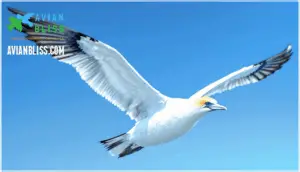This site is supported by our readers. We may earn a commission, at no cost to you, if you purchase through links.

These notable seabirds, among the North Atlantic’s most iconic residents, combine striking beauty with exceptional hunting prowess, making them one of nature’s most efficient ocean predators. From their jet-black wingtips and golden crowns to their dramatic plunge-diving hunts, northern gannets represent a masterclass in evolutionary adaptation.
Whether you’re a birdwatcher trying to spot them along coastal cliffs or simply curious about how these birds thrive in one of Earth’s most active ocean systems, understanding what makes the northern gannet tick reveals a creature built for survival in ways that are both elegant and brutal.
Table Of Contents
- Key Takeaways
- Northern Gannet Appearance and Identification
- Habitat and Distribution of Northern Gannets
- Breeding and Nesting Behaviors
- Feeding Habits and Hunting Strategies
- Conservation Status and Current Threats
- Frequently Asked Questions (FAQs)
- How long can Northern Gannet stay underwater?
- What are some cool facts about Northern Gannets?
- Where do Northern Gannets live?
- What is the difference between a cape gannet and a Northern Gannet?
- What is the migration pattern of northern gannets?
- How do northern gannets interact with other seabirds?
- Are northern gannets affected by marine pollution?
- What is a typical lifespan of a northern gannet?
- How do northern gannets communicate with each other?
- How long do northern gannets live in the wild?
- Conclusion
Key Takeaways
- Northern gannets dive at speeds exceeding 100 km/h from heights of 10–60 meters, using specialized anatomical features like reinforced skulls and elastic neck vertebrae to withstand impacts up to 6 Gs and pluck fish with precision underwater.
- Climate change has shifted gannet breeding ranges northward by 7.7° since 1935, but southern colonies now face breeding failure as warming waters deplete Atlantic mackerel stocks, forcing adults to forage 400 km from nesting sites—double historical distances.
- These seabirds maintain monogamous pair bonds with 80% mate retention annually, return to the same cliff nests year after year, and raise a single chick per breeding season through 13 weeks of intensive parental care requiring both parents to make foraging trips spanning up to 320 km.
- Avian influenza devastated colonies in 2022, causing 50% population declines at major sites, while plastic debris appears in 46% of nests and tourism disturbance reduces fledgling success by 60%, highlighting how human activities and disease now pose greater threats than the species’ historic near-extinction.
Northern Gannet Appearance and Identification
If you’ve ever watched a snowy white seabird with jet-black wingtips plunge into the ocean like an arrow, you’ve probably seen a Northern Gannet in action. Identifying this striking seabird isn’t difficult once you know what to look for, from its size and coloring to how it changes as it matures.
Here’s what you need to recognize a Northern Gannet whether it’s soaring overhead or perched on a distant cliff.
Physical Characteristics and Size
You’ll recognize an adult northern gannet by its impressive size—ranging from 87 to 110 cm in length with a wingspan stretching up to 184 cm. Adults display striking white plumage with jet-black wingtips and a golden-yellow crown, while their blue-grey bill and vivid blue eye ring provide key identification markers. Weighing between 2.3 and 3.6 kg, they’re the largest member of the gannet family, with minimal sexual dimorphism between males and females.
Research suggests that differences in foraging ecology are linked to differing energy demands and conduct.
Plumage Changes by Age
You’ll notice that northern gannet plumage development follows a predictable four-to-five-year progression. Juvenile birds start with dark brown plumage flecked with white speckling, gradually acquiring more white feathers through successive molting patterns.
During the immature intermediate stage, you’ll see irregular patches of dark and white as they progress through their second and third years.
Subadult stage gannets display mostly white bodies with residual dark spots before finally achieving full adult plumage—white with black wingtips and that distinctive golden crown.
Distinctive Features in Flight
When you see northern gannets in flight, their long slender wings and black wingtips create a striking silhouette. They cruise at 55–65 km/h, alternating powerful wingbeats with extended glides.
Watch for their sleek, cigar-shaped bodies and energetic soaring techniques as they exploit wind currents above waves.
Plunge-diving gannets fold their wings tightly, reaching speeds over 100 km/h before impact—a breathtaking display of diving aerodynamics perfected for hunting. Their body structure allows for impressive force mitigation upon water entry.
Key Identification Tips for Birdwatchers
To confidently identify northern gannets in the field, focus on adults’ snowy white plumage paired with jet-black wingtips and a distinctive yellowish crown. Their blue-grey conical bill and black facial mask set them apart from other seabirds. Watch for flight patterns featuring shallow wingbeats and long glides.
Juvenile markings show mottled brown coloration that gradually whitens over several years. Leg color reveals subtle greenish or bluish lines along the toes—helpful details for your seabird identification guide when studying gannet appearance and characteristics.
Habitat and Distribution of Northern Gannets
Northern gannets spend most of their lives at sea, but they return to specific locations to breed and raise their young. Understanding where these impressive seabirds live throughout the year helps you appreciate their adaptability to different marine environments.
Let’s explore the key aspects of their habitat and range across the North Atlantic.
Breeding Colonies on Sea Cliffs
Northern Gannet nesting colonies transform steep sea cliffs into bustling, noisy cities during breeding season. These cliffside colonies cling to rock faces and islands where predators can’t reach, rising from the high-tide mark to over 200 meters elevation.
You’ll find gannet breeding colonies concentrated where ocean currents like the Gulf Stream deliver fish-rich waters close to shore. Colony population density reaches impressive levels—Bass Rock in Scotland packed nearly 48,000 nests into accessible survey areas in 2023.
Cliff site selection hinges on updrafts for takeoffs and foraging habitat proximity to continental shelves.
Year-Round Range and Migration Patterns
Between late September and mid-November, adult northern gannets leave their breeding colonies, following Atlantic coastlines toward subtropical wintering grounds off western Africa and the Gulf of Mexico.
These migration patterns show striking age differences—immatures wander much farther south than adults, sometimes reaching the Caribbean or even Ecuador. Migration corridors span 800 to 1,600 kilometers, with birds covering 250 to 450 kilometers daily.
Oceanographic influences matter: you’ll find gannets tracking productive currents, upwelling zones, and thermal fronts where fish concentrate during their journeys.
Major Locations and Population Hotspots
Across the North Atlantic, you’ll find breeding colonies of gannets clustering on remote cliffs and islands that serve as key breeding sites. Cape St. Marys, Newfoundland, hosts around 30,000 northern gannets, making it North America’s largest colony along the Atlantic Coast. Scotland’s Bass Rock claims the global crown with over 51,000 occupied sites, though avian influenza caused recent colony size trends to shift downward.
Together, 444,000 nesting pairs occupy 38 colonies across both continents, their population genetic structure reflecting historical habitat loss impact and ongoing conservation site management efforts.
Preferred Oceanic Environments
You’ll find these seabirds thriving where cold meets productive—in temperate North Atlantic waters between 8°C and 18°C sea temperature. Northern Gannet habitat centers on continental shelf waters 50 to 200 meters deep, where shelf fronts concentrate prey like herring and mackerel.
They forage within 60 to 232 km of colony proximity, targeting offshore waters along the latitudinal range from Newfoundland to Norway.
This marine ecosystem’s structure—moderate depths, nutrient-rich fronts, and accessible marine habitat—defines their oceanic world.
Breeding and Nesting Behaviors
Northern gannets don’t just show up at sea cliffs by accident—they return to the same bustling colonies year after year, where breeding follows a precise rhythm shaped by strong social bonds and harsh Atlantic conditions.
From selecting a mate to raising a single chick in a tightly packed neighborhood, their nesting habits reveal how these seabirds balance cooperation with competition.
Here’s what you need to know about how northern gannets reproduce and raise their young.
Mate Selection and Pair Bonding
When you’re looking at mating habits of gannets, you’ll notice females are surprisingly choosy. They select males based on nest site quality and display vigor, often circling colonies multiple times before committing.
Northern gannets are monogamous, maintaining pair bonds across seasons with mate retention exceeding 80% annually. Site fidelity strengthens these bonds, as couples return to the same cliffs year after year.
However, environmental impacts matter—when prey becomes scarce, divorce rates can jump from around 10% to 22%, directly affecting reproductive success and nesting habits.
Nest Construction and Materials
When you watch gannets construct their nests, you’re witnessing a multigenerational building project. Males start with a scrape, then layer grass, algae, feathers, and mud into a compressed pedestal that hardens with time. Here’s what makes their architecture striking:
- Strategic placement — Nests cluster on windward cliff faces where updrafts aid takeoff and landing, with hexagonal spacing allowing maximum density across colonies.
- Recycled materials — Pairs return yearly to the same site, adding seaweed, moss, and sticks, transforming modest 8-inch nests into towering 40-inch structures.
- Debris incorporation — Gannets actively select fishing-related plastics—rope, net fragments—with 28 of 29 monitored colonies containing anthropogenic debris, reflecting local fishing effort.
These nesting actions reveal how gannets balance efficiency, tradition, and environmental adaptation across their breeding sites.
Egg Laying and Chick Rearing
Once nests are established, gannets commit to a single egg per breeding season, laid between late March and April. Your clutch size stays constant—one egg, roughly 3.2 inches long and weighing about 104 grams, colored pale blue or greenish before fading chalky white.
Both parents share incubation shifts, managing the 42–46 day incubation period by cradling the egg beneath their webbed feet rather than their bodies, preventing overheating on cliff ledges.
Chicks hatch altricial and dark, developing white down within two weeks. Parents regurgitate semi-digested fish initially, switching to whole prey as nestlings grow.
The nestling period spans 82–99 days of intensive parental care, though chick mortality remains higher in inexperienced breeders who accidentally crush eggs late in incubation. By fledging age, young gannets achieve independence, though juvenile survival depends heavily on mastering ocean feeding before their first winter at sea.
Colony Structure and Social Dynamics
While single eggs hatch into dependent chicks, the real test begins when thousands of breeding pairs crowd onto narrow ledges. Your colony operates as a tightly packed neighborhood where nesting proximity averages 2.5 to 3.5 nests per square meter—roughly 600 to 900 millimeters apart. This density creates inevitable friction. Territorial aggression flares as males bill-lock and push for weeks, establishing dominance through ritualized displays and headshakes.
But here’s what keeps this crowded world from chaos: social hierarchies and cooperative aspects stabilize everything. Pairs share incubation duties equally, alternating 2–3 day shifts. Synchronized movements improve group vigilance during migration. Juvenile clubs form, where young gannets socialize before reaching breeding maturity at four to five years. Strong colony fidelity means pairs return annually to the same nest sites, building multigenerational stability.
The spatial organization—those hexagonal patterns—maximizes airflow and reduces disease transmission. Even at Bass Rock’s 150,000 birds, this structured community holds.
Feeding Habits and Hunting Strategies
Northern gannets are built for hunting, and their feeding strategy is as impressive as it’s dramatic. Whether you’re watching them from a clifftop or reading about their ocean habits, understanding how they catch food reveals what makes these birds such successful predators.
Let’s explore the techniques, prey, and patterns that fuel their lives at sea.
Plunge-Diving Technique
Northern gannets execute one of nature’s most dramatic feeding strategies through precision plunge-diving. You’ll witness them diving from heights of 10–60 meters, entering the water at speeds exceeding 100 km/h with dive angles between 60–80 degrees. Their sleek bodies and tapered beaks minimize drag, while specialized neck vertebrae—around 15 segments with elastic structures—absorb catastrophic impact biomechanics.
Northern gannets plunge-dive from heights exceeding 60 meters at speeds over 100 km/h, their specialized neck vertebrae absorbing catastrophic impact while tapered beaks and sleek bodies minimize drag
Hydrodynamic adaptations allow gannets to withstand up to 6 Gs at impact. Once submerged, underwater vision accommodation exceeding 45 diopters lets you observe their rapid prey tracking during the momentum and wing-flapping phases.
Dive optimization varies based on variability, as individual gannets adjust plunge height, angle, and entry orientation according to prey school depth and sea conditions, maximizing foraging success through this striking gannet feeding pattern.
Diet and Prey Preferences
Once gannets enter the water, their feeding strategy shifts to precision prey selection. Atlantic mackerel dominates their diet, comprising up to 54% of intake across breeding seasons, though herring and capelin are important depending on local stock abundance.
Prey composition varies seasonally—chicks receive smaller, energy-dense fish averaging 438–800 grams daily, while adults consume more diverse prey outside breeding.
Prey availability directly shapes reproductive success; when mackerel declines at southern colonies, breeding outcomes suffer greatly. Gannets remain flexible feeders, occasionally supplementing natural prey with fishery discards during poor fish years, though these represent less than 5% of their diet when shoaling fish stocks remain strong.
Foraging Areas and Patterns
Across the North Atlantic, gannets strategically target productive fishing grounds shaped by ocean currents and prey availability. Foraging ranges vary dramatically: birds from smaller colonies average 63.6 km trips, while those from massive colonies like Bass Rock travel over 150 km per journey, burning significant energy competing for depleted local resources. Trip timing peaks during chick-rearing when feeding demands spike, then declines as the breeding season winds down. Seasonal patterns reflect daylight-dependent foraging, with trips averaging 22 hours and distances near 408 km. Environmental influences—from Gulf Stream productivity to mackerel migrations driven by warming—dictate where feeding gannets will be found.
Key Foraging Patterns:
- Foraging range expands with colony size, forcing birds from crowded breeding sites to travel farther offshore than smaller populations
- Seasonal patterns intensify during chick-rearing, with trip frequency and distance peaking when nutritional demands on parents reach maximum levels
- Energy expenditure correlates with oceanographic productivity, driving gannets to adjust effort based on local fish availability and water temperature
- Environmental influences include ocean warming effects, which have shifted breeding ranges northward by 7.7° since 1935 following prey migrations
- Gannet feeding actions show striking fidelity to continental shelf hotspots, particularly around productive areas influenced by the Gulf Stream and upwelling zones
Feeding Young and Parental Care
From hatching through fledging, you’re watching one of nature’s most demanding parental investments. Both parents regurgitate semi-digested fish to newly hatched chicks, shifting to whole prey as digestive capacity matures. During the 13-week nestling period, chicks consume roughly 24 kg of fish—herring, sand lance, cod, and pollock dominate the diet.
Parents alternate nest attendance and foraging trips spanning up to 320 km, balancing predation risk against chick energy demands. This intensive gannet parental care produces fledglings weighing nearly adult mass, though post-fledging survival remains brutal: approximately 60–65% of juveniles don’t survive their first year at sea.
Conservation Status and Current Threats
Northern Gannets have made an impressive recovery from near extinction, but they still face real challenges in today’s ocean.
Climate change is reshaping the waters they depend on, while human activities like fishing accidents and boat strikes pose ongoing risks.
Understanding these threats and the efforts to protect them gives you insight into why these striking seabirds matter—and what’s being done to keep their populations thriving.
Impacts of Climate Change
Climate change reshapes Northern Gannet survival in profound ways. Rising ocean temperatures have shifted breeding range poleward by 7.7° latitude since 1935, concentrating populations northward where prey remains abundant.
Yet this migration masks troubling trade-offs: southern colonies face plummeting breeding success—Cape St. Mary’s dropped to 0.39 fledglings per nest in 2017 as warming waters depleted Atlantic mackerel stocks. Adults now forage 400 km from nesting sites, doubling historical distances, straining chick survival.
Disease outbreaks compound these pressures, while declining prey availability and breeding failures signal conservation urgency despite the species’ historic resilience.
Human Interactions and Risks
Human activities pose mounting threats to northern gannet survival. Tourism disturbance at breeding colonies directly reduces breeding success—a 2017 study documented 60% fewer fledglings in areas with heavy visitor access, as nest abandonment exposed eggs to predation.
Fishing entanglement remains pervasive, with plastic and other trash from nets present in 46% of nests examined, while bycatch mortality from gillnets claims additional birds. Fishing accidents and direct mortality from fisheries conflict continue despite stable populations overall.
Disease transmission accelerated dramatically when avian influenza swept through 41 colonies in 2022, causing 50% population declines at major sites. Chemical contaminants and toxic heavy metals accumulate in gannet tissues through their high-trophic diet, compromising reproduction and chick development.
Ongoing Protection and Research Efforts
Protecting gannets takes teamwork across borders and disciplines. Since the 2022 avian influenza outbreak devastated major colonies like Bass Rock—where occupied sites plummeted 31%—researchers intensified disease surveillance and biosecurity protocols. Legal frameworks, including the EU Birds Directive and UK Wildlife Act, designate breeding sites as Special Protection Areas with strict seasonal access restrictions. Here’s what’s driving recovery:
- Population monitoring uses GPS tracking, drone surveys, and satellite telemetry across 21 colonies, capturing 7,100+ foraging trips to detect population trends.
- Disease outbreak response coordinates avian influenza screening and field sampling through international consortia, accelerating impact assessments.
- Legal protection establishes regulated fishing zones around foraging grounds and enforces no-entry buffers during the breeding season.
- Collaborative research unites ornithologists, marine ecologists, and policymakers—organizations like BirdLife International lead seabird conservation efforts globally.
- Public engagement harnesses citizen science, visitor programs, and awareness campaigns to supplement professional monitoring efforts.
Frequently Asked Questions (FAQs)
How long can Northern Gannet stay underwater?
Underwater diving duration remains poorly documented, but physiological adaptations enable extended breath-holding. Their oxygen storage capacity and efficient hunting depth allow foraging dives lasting several minutes, supporting effective gannet feeding actions during prey capture underwater.
What are some cool facts about Northern Gannets?
Northern Gannets plunge-dive from 30 meters at speeds exceeding 100 km/h to snag fish. Their specialized bills, reinforced skulls, and vocal communication during hunts reduce collisions.
Colonies host thousands; birds live 30+ years, taking four years to achieve snowy-white adult plumage from brown juvenile feathers.
Where do Northern Gannets live?
These seabirds inhabit cold North Atlantic waters, breeding on coastal cliffs across Canada, Iceland, Norway, and the UK.
You’ll find them foraging over continental shelves during migration patterns, with major colony locations spanning from Newfoundland to France—their distribution factors shaped entirely by oceanic environments and nesting site availability.
What is the difference between a cape gannet and a Northern Gannet?
Cape gannets differ from their northern cousins through genetic divergence and distinct plumage variations. While both are large seabirds, adults show key species comparison traits: Cape gannets possess all-black secondaries and usually all-black tails, whereas Northern gannets retain white tails with black wingtips only.
Northern gannets are slightly larger, averaging 89–100 cm versus Cape gannets’ 84 cm. Habitat overlap remains minimal—Cape gannets inhabit southern African waters while Northern gannets breed across the North Atlantic.
What is the migration pattern of northern gannets?
Like a compass needle drawn inexorably toward magnetic north, these seabirds undertake seasonal journeys shaped by shifting food availability. Migration triggers include declining water temperatures and prey depletion.
Most northern gannets migrate between breeding colonies on North Atlantic cliffs and wintering grounds along the Atlantic Coast, from New York to North Carolina. Juveniles disperse widely from stopover sites, establishing flight paths that span thousands of miles before settling into regional wintering patterns.
How do northern gannets interact with other seabirds?
In bird colonies, competition drives interactions between species. Gannets assert dominance through aggressive displays, monopolizing prime nesting sites and foraging grounds.
During interspecies foraging, seabird communication—vocalizations and body language—helps coordinate mixed-species feeding flocks, reducing predator avoidance costs.
Some symbiotic relationships emerge; gannets benefit from other seabirds’ early warning systems against threats, creating mutual colony protection benefits.
Are northern gannets affected by marine pollution?
Marine pollution creates a perfect storm for gannets—these diving specialists face triple threats. Plastic ingestion and entanglement risks compromise their hunting efficiency, while oil spills and chemical pollutants degrade their marine ecosystem.
Toxic contaminants accumulate through their food chain, driving population decline despite conservation gains and climate change pressures.
What is a typical lifespan of a northern gannet?
Most northern gannets live 25–30 years in the wild, though some reach their early forties. Maturity takes four years to achieve full plumage, delaying breeding.
Lifespan factors include fishing accidents, disease, and climate-driven food scarcity. Mortality causes greatly shape population dynamics across breeding colonies.
How do northern gannets communicate with each other?
Imagine watching a massive colony of gannets on a cliff face—hundreds of birds calling out simultaneously. Gannets communicate through vocalizations, visual signals, and body language. They produce distinctive calls during diving to coordinate hunting and avoid mid-air collisions.
Mating rituals involve elaborate displays and vocalizations that strengthen pair bonds. Chicks vocalize to demand food from parents.
These colony communication methods help them navigate their crowded cliff communities and maintain social hierarchies efficiently.
How long do northern gannets live in the wild?
In the wild, these seabirds usually live 25 to 30 years, though some individuals reach their early 40s. Lifespan factors include disease, fishing accidents, and climate-driven prey scarcity.
The aging process slows after they attain full adult plumage around year four, yet wild threats—from pollution to starvation—greatly impact longevity and population stability throughout their life cycle.
Conclusion
You might assume the northern gannet’s dramatic plunge-dive is purely instinctive, but research reveals complex cognitive planning. These birds calculate trajectory, depth, and timing with impressive precision.
The northern gannet isn’t simply following programmed action; it’s solving complex physics problems in real time. This combination of anatomical specialization and adaptive intelligence makes gannets enduring survivors in fluctuating ocean ecosystems, rewarding your closer attention.











